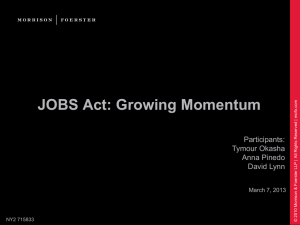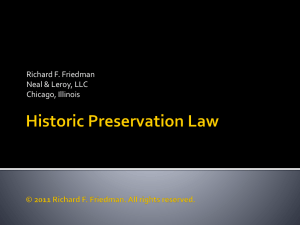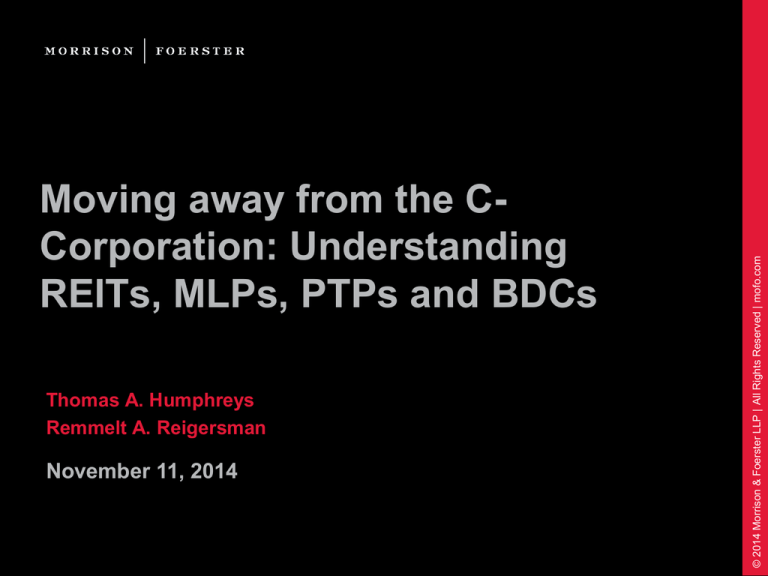
Thomas A. Humphreys
Remmelt A. Reigersman
November 11, 2014
© 2014 Morrison & Foerster LLP | All Rights Reserved | mofo.com
Moving away from the CCorporation: Understanding
REITs, MLPs, PTPs and BDCs
Agenda
Overview
Up-Cs
REIT Conversions
BDCs
Optimized MLPs
Kinder Morgan Exception
Tax Reform?
This is MoFo.
2
Overview: Primer on Tax Pass-Thrus
Corporations subject to 35% federal income tax; shareholders
subject to tax on dividends received at 39.6% maximum rate (20%
for “qualified dividends”)
The U.S. Internal Revenue Code creates various pass-thru entities:
Partnerships (general partnerships, limited partnerships or limited liability
companies under state law) that are not publicly traded
Publicly traded partnerships that engage in certain activities such as oil and gas
production
Real estate investment trusts (“REIT”s)—corporations for tax purposes that hold
mostly real estate assets like real estate or mortgages and earn mostly passive
income
Regulated investment companies (“RIC”s)—corporations for tax purposes that hold
securities and earn mostly passive income
This is MoFo.
3
Common Theme
Taxpayers will gravitate over time to structures that optimize the
different entity taxation regimes
They will use tax pass-thrus to the extent possible, with only those
activities that must be in corporate solution in corporations
At a certain size, certain pass-thrus (e.g., MLPs) may revert back to
taxable corporation status (Kinder Morgan Exception)
This is MoFo.
4
Up-C
This is MoFo.
5
Up-C
Historic
Partners
The Up-C structure has become increasingly
common for IPOs of companies that have
historically operated as partnerships
Public
Investors
100%
Class B
Shares
100%
Class A
Shares
(majority voting power)
(0% economics)
(minority voting power)
(100% economics)
PubCo
The Up-C structure derives its name from the
UPREIT structure. Essentially, a newly
formed corporation (“PubCo”) will be the
entity that undertakes the IPO. PubCo will sit
above an existing limited liability company
(the “LLC”)
Partnership
Interest
and
Managing
Member
Partnership
Interests
Partnership
or LLC
Operating
Subsidiaries
Up-C Structure Final State
This is MoFo.
6
Up-C (cont.)
Historic
Partners
PubCo will be a holding company and will
have as its subsidiary the LLC. The principal
assets/operating business will continue to be
at (or below) the LLC level
PubCo will receive the IPO proceeds and
downstream the proceeds to the LLC
Public
Investors
100%
Class B
Shares
100%
Class A
Shares
(majority voting power)
(0% economics)
(minority voting power)
(100% economics)
PubCo
Partnership
Interest
and
Managing
Member
Partnership
Interests
Partnership
or LLC
Operating
Subsidiaries
Up-C Structure Final State
This is MoFo.
7
Typical Pre-IPO Structure - Corporation
Historic Shareholders
Disadvantages
•
Income from operating subsidiaries
subject to entity-level tax when
earned by the corporation
•
Historic partners (and other
shareholders) subject to tax when
they receive dividends
C Corporation
This is MoFo.
8
Typical Pre-IPO Structure - Partnership
Advantage
Historic Partners
•
Partnership not subject to tax;
income earned by operating
subsidiaries taxable directly to
partners
LLC
Disadvantage
•
This is MoFo.
Listing partnership when going public
may result in the partnership being
taxed as a corporation
9
Up-C Structure: Immediately After Formation of C-Corp
Historic Partners
Company incorporated in Delaware
with two classes of common stock,
Class A and Class B. Class A is offered in
the IPO and Class B is held by the
Historic Partners and provides no
economic rights, only voting rights
Controlling voting
interest
PubCo
(Delaware C-Corp)
This is MoFo.
100% economic
interest
LLC
10
Up-C Structure: Immediately following IPO
Historic Partners
Public Shareholders*
(Class A Holders)
Cash
Voting interest
100% economic
interest
• 100% economic interest
• Minority voting interest
PubCo
(Delaware C-Corp)
LLC
* Public shareholders purchase their shares for cash in the IPO
This is MoFo.
11
Up-C Structure: Final Structure
Historic Partners
Class A Holders
60% voting interest
$
60% economic
interest
LLC interests
convertible into
shares of Class A
common stock
• 100% economic interest
• 40% voting interest
$
PubCo
(Delaware C-Corp)
•
•
•40% economic
interest
•Sole managing
member
LLC
PubCo uses the proceeds received in the IPO to purchase LLC interests
LLC redeems partnership interests from the Historic Partners (treated for tax purposes as a
“disguised sale” or direct purchase of partnership interests by PubCo from the Historic Partners)
(percentages are included only for illustrative purposes)
This is MoFo.
12
Why an Up-C structure?
Prior to the IPO, the business was conducted through an LLC, which
is a pass-through structure and does not pay entity-level taxes
Through the Up-C structure, the pass-through structure remains in
place and PubCo pays the pre-IPO equity holders (LLC members) for
the value of PubCo’s tax attributes as those tax attributes are used
after the IPO. This creates a market dynamic that permits value to
be extracted from PubCo after the IPO, without decreasing the value
of PubCo in the offering
This is MoFo.
13
Why an Up-C structure (cont.)?
To effectuate the Up-C structure, PubCo will enter into various
arrangements with the LLC and its members. These include an LLC
operating agreement and Tax Receivable Agreement (“TRA”).
Generally, TRAs do not appear to impact the valuation of a
corporation in its IPO
This is MoFo.
14
Why an Up-C structure (cont.)?
Public stockholders often do not assign full value to the tax attributes
of a corporation. Similarly, public stockholders apparently do not
discount the value of a corporation to account fully for future
payments to be made under a TRA. Through the TRA, the IPO
corporation pays for a valuable tax attribute (for example, a basis
step-up)
This is MoFo.
15
Tax Receivable Agreements
PubCo
(Delaware C-Corp)
Tax
Receivable
Agreement
Historic Partners
•40%
economic
interest
•Sole
managing
member
60% economic interest
LLC interests
convertible into
shares of Class A
common stock
LLC
(percentages are included only for illustrative purposes)
This is MoFo.
16
Benefits of the Tax Receivable Agreement
Because the historic partners sell partnership interests to PubCo (rather than
stock, as in a traditional IPO structure), PubCo receives a “step-up” in the
tax basis of its assets
This tax basis step-up is allocated to PubCo’s share of the historic
partnership’s assets, and in many cases the step-up is primarily allocable to
intangible assets that are amortizable on a straight-line basis over 15 years
(so-called “Section 197” intangibles)
Through a TRA the historic partners effectively capture the majority of the
value associated with the PubCo’s tax basis step-up
This is MoFo.
17
Benefits of the Tax Receivable Agreement (cont.)
Under the terms of the TRA, PubCo is obligated to pay the historic partners
in cash an amount equal to PubCo’s tax savings generated by the tax basis
step-up (typically 85% of such savings)
Payments under the TRA are effectively treated as additional purchase price
paid by PubCo for its interest in the historic partnership
This is MoFo.
18
Benefits of the Tax Receivable Agreement (cont.)
Illustration of Potential TRA Economics
Amount of PubCo Tax Basis Step-Up*
$300 million
Amortization Period
15 years
Annual Amortization
$20 million
PubCo Tax Rate (Federal & State)
40%
PubCo Annual Savings
$8 million
TRA Payout Ratio
85%
Annual Payment to Historic Partners**
$6.8 million
Total Payments to Historic Partners
$102 million
*Any future exchanges of partnership units for Class A shares of PubCo also may
give rise to additional tax basis step-up for PubCo (thereby increasing the
amounts payable under the TRA over time)
**Payments under the TRA also give rise to additional tax basis step-up for PubCo
(thereby increasing the amounts payable under the TRA over time)
This is MoFo.
19
Additional Considerations Related to Up-C Structure
The Up-C structure maintains continuing pass-through treatment
(single level taxation) for the historic partners with respect to their
proportionate share of net income realized by the partnership
The historic partners obtain liquidity through the right to exchange
partnership units for Class A shares of PubCo
The Up-C structure provides a range of options for making
strategic acquisitions and compensating employees (e.g., PubCo
stock, PubCo options, and partnership units)
This is MoFo.
20
Additional Considerations Related to Up-C Structure
(cont.)
PubCo becomes the managing member of the historic partnership
and the historic partners retain voting control through Class B
PubCo shares
PubCo consolidates the historic partnership for financial statement
purposes
This is MoFo.
21
Miscellaneous Issues Related to Up-C Structure
“Anti-churning rules” under Section 197 of the Internal Revenue Code
Tax distributions to PubCo and historic partners
Continuing administration of TRA and determination of annual
payments to be made by PubCo to historic partners (reviewed and
approved by PubCo audit committee in conjunction with outside
advisors)
Investment Company Act (“40 Act”) status of PubCo
This is MoFo.
22
REIT Conversions
This is MoFo.
23
REIT Conversions
Penn National Gaming
CBS Outdoor
This is MoFo.
24
Penn National Gaming
Carlino Family
Public
14.5%
Penn
National
Gaming, Inc.
(“PENN”)
19 Casinos
• Goal: separate the real estate from the operating assets and allow real
estate to trade separately, achieving a higher valuation multiple for those
assets
This is MoFo.
25
Related Party Rents
Rent paid to a REIT is not “qualifying” if REIT owns 10% or more of
tenant
Attribution rules: if a shareholder owns 10% (or more) of both REIT
and tenant then REIT considered to own 10% (or more) of tenant
This is MoFo.
26
Penn National Gaming (cont.)
Carlino Family
Public
REIT Shares
Exchange PENN Shares
(to bring Family below 10%)
PENN
REIT
This is MoFo.
27
Penn National Gaming (cont.)
Public/Family
Tax Free Spin-off
100%
PENN
Operating
Assets
This is MoFo.
Gaming and
Leisure
Properties, Inc.
(“GLPI”)
REIT
28
Penn National Gaming (cont.)
Family (9.9%)
Penn
(“OpCo”)
Public
Lease
Rent
Family (16.3%)
GLPI
(“PropCo”)
REIT
TRS
Real Estate
Two Casinos
• Distribution of GLPI stock is tax free
• Restrictions on PENN and GLPI stock sales post spin-off
• IRS private letter ruling confirms tax treatment
This is MoFo.
29
CBS Outdoor
2
83% Tax Free Split-off
Public
CBS
Corporation
CBS Outdoor
Americas Inc.
REIT
This is MoFo.
1
17% IPO
30
CBS Outdoor (cont.)
Public
Public
(former CBS shareholders
that have elected to take
REIT shares and give up
their CBS shares)
Lease
CBS
Rent
This is MoFo.
IPO shares
CBS Outdoor
Americas Inc.
REIT
Real Estate (outdoor
ad displays)
31
BDCs
This is MoFo.
32
BDCs
Business development companies register with the SEC under the
Investment Company Act of 1940
BDCs can either be partnerships for tax purposes or “regulated
investment companies” under Subchapter M of the Code
RIC provisions in IRC §851-§855 are like REIT provisions: they
permit a RIC to pay dividends to shareholders that the RIC deducts
in computing taxable income
RIC requirements include income tests (income from passive
sources like dividends and interest) and asset tests (assets must be
a diversified pool of securities)
A publicly traded partnership that is registered with the SEC under
the ‘40 Act must elect RIC status, i.e., it cannot be a PTP taxed as a
partnership
This is MoFo.
33
Optimized MLPs
This is MoFo.
34
MLP Basics
In 1987 Congress passed IRC section 7704 which treats a “publicly
traded partnership” as a corporation for federal income tax purposes
The exceptions to the rule were substantial, however
A partnership with 90% or more qualifying income for the taxable
year was excepted and, therefore, treated as a corporation
Qualifying income includes the normal types of passive income
including interest, dividends, rents, etc.
However, income from natural resources was also included
This is MoFo.
35
MLP Basics (cont.)
Broad definition of natural resource income: “income and gains
derived from the exploration, development, mining or production,
processing, refining, transportation (including pipelines transporting
gas, oil, or products thereof), or the marketing of any mineral or
natural resource (including fertilizer, geothermal energy, and timber),
industrial source carbon dioxide, or the transportation or storage of
any fuel described in subsection (b) , (c) , (d) , or (e) of section 6426,
or any alcohol fuel defined in section 6426(b)(4)(A) or any biodiesel
fuel as defined in section 40A(d)(1).”
This is MoFo.
36
MLP Basics (cont.)
Issuer
Business Description
Offer Date
Antero
Midstream
Partners LP
Owns, operates and develops
midstream gathering, compression
and pipeline assets
11/10/2014
Shell Midstream
Partners, L.P.
Owns and operates crude oil and
refined product pipelines
10/29/2014
Dominion
Midstream
Partners, LP
Owns, operates and develops natural
gas infrastructure assets
10/15/2014
USD Partners LP Owns a crude oil rail terminal
10/8/2014
JP Energy
Partners LP
10/2/2014
This is MoFo.
Owns, operates and develops
midstream energy assets
37
Optimized MLPs
Public (Tax
Exempts/non-U.S.)
C Corp
(“blocker”)
Public (U.S.)
MLP
This is MoFo.
38
Hiatus in MLP Rulings – March 2014
Why?
When will it end?
This is MoFo.
39
Kinder Morgan Exception
This is MoFo.
40
Kinder Morgan Exception
Kinder Morgan, Inc. (“KMI”) is the general partner of two large
publicly traded partnerships: Kinder Morgan Energy Partners LP and
El Paso Pipeline Partners LP; it also owns the voting interests in
another publicly traded entity treated as a corporation for tax
purposes: Kinder Morgan Management LLC
On August 10, 2014 Kinder Morgan announced plans to purchase
the outstanding interests in these three entities.
Going forward, KMI, a C corporation for tax purposes, will operate all
these businesses with a total enterprise value of $140 billion
CEO Richard D. Kinder: “This transaction dramatically simplifies the
Kinder Morgan story by transitioning from four separately traded
equity securities today to one security going forward…”
This is MoFo.
41
Takeaways
Continued expansion of UP-C structure and C Corp/MLP structures
Real estate intensive businesses will continue to attempt to unlock
value through REIT conversions and spin-offs
There may be a natural limit on the size of a pass-through (or maybe
not…)
This is MoFo.
42
Tax Reform?
This is MoFo.
43
Tax Reform?
Beginning in 2013 Rep. Dave Camp (R-MI) released “discussion
drafts” of draft tax reform legislation
No legislation has been introduced
No hearings have been held on the discussion drafts
Rep. Camp is retiring this year
Impact of recent elections?
This is MoFo.
44
Tax Reform?
Pass-Thru and Certain Other Entities
Publicly traded partnership exception restricted to mining and natural resources
partnerships
Prevention of tax-free spinoffs involving REITs
Certain short-life property not treated as real property for purposes of REIT
provisions
Repeal of special rules for timber held by REITs
Non-REIT earnings and profits required to be distributed by REIT in cash
This is MoFo.
45
Tax Reform?
Pass-Thru and Certain Other Entities
Debt instruments of publicly offered REITs and mortgages treated as real estate
assets
Reduction in percentage limitation (to 20% from 25%) on assets of REIT which
may be taxable REIT subsidiaries
Recognition of net built-in gain on assets when a C corporation converts to a REIT
or RIC, or when a REIT or RIC acquires assets from a C corporation in a carryover
basis transaction
This is MoFo.
46
Contact Information
Federal Tax
Thomas A. Humphreys
(212) 468-8006
thumphreys@mofo.com
Remmelt A. Reigersman
(212) 336-4259
rreigersman@mofo.com
This is MoFo.
47


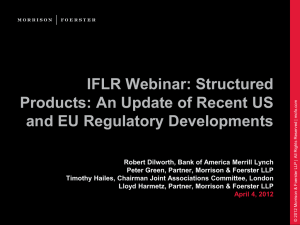

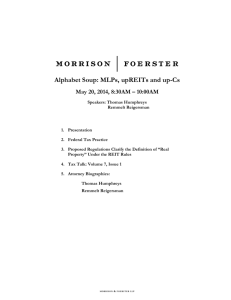

![Your_Solutions_LLC_-_New_Business3[1]](http://s2.studylib.net/store/data/005544494_1-444a738d95c4d66d28ef7ef4e25c86f0-300x300.png)

